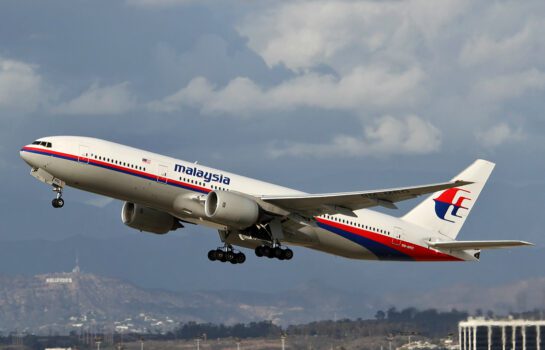The Vanishing of Flight MH370: Aviation Mystery
On the night of March 8, 2014, Malaysia Airlines Flight MH370 took off from Kuala Lumpur International Airport in Malaysia, bound for Beijing Capital International Airport in China. Onboard were 239 people: 227 passengers and 12 crew members. The passengers were from 14 different nations, most of them Chinese, along with Malaysians, Australians, and others from around the world. The aircraft, a Boeing 777-200ER, was among the safest and most reliable commercial aircraft models, with an excellent track record.
The weather was calm, the crew experienced, and the flight had a routine departure at 12:41 a.m. Everything about the early moments of MH370 appeared normal, until it wasn’t.
Roughly 38 minutes into the flight, while cruising over the South China Sea, MH370 vanished from civilian radar screens. The last words from the cockpit were chilling in their ordinariness: “Good night Malaysian three-seven-zero.” That would be the last time the world heard from Flight MH370.
The Vanishing
Air traffic controllers expected the flight to transfer to Vietnamese airspace. But MH370 never checked in. In fact, moments after crossing into the Ho Chi Minh flight information region, the plane simply disappeared. No distress signal, no emergency transmission, no sign of trouble.
Military radar data later revealed something stunning: shortly after its last civilian radar detection, the aircraft had made an unexpected turn west, crossing back over the Malay Peninsula and flying over the Andaman Sea. Then it vanished again, this time for good.
This radical course deviation stunned investigators. What could have caused such a change? Mechanical failure? Hijacking? A pilot suicide? A political plot? Theories began to mount as the world struggled to understand how a modern jetliner could simply vanish in the era of real-time GPS, satellite phones, and global tracking.
A Global Search Begins
The disappearance triggered one of the largest and most expensive search efforts in aviation history, involving 26 countries. At first, the search focused on the South China Sea, where the plane had last communicated. But as new satellite data emerged, it became clear that investigators had been looking in the wrong place.
The British company Inmarsat had picked up “handshakes”, hourly automatic communications between the aircraft and a satellite. These pings, though lacking precise location data, suggested that MH370 had flown for several more hours after losing radar contact, eventually heading south into the remote southern Indian Ocean.
This new information shifted the search zone to a vast, deep, and unforgiving part of the world’s oceans, far off the western coast of Australia. But this area, now called the “Seventh Arc,” was massive. Even with sophisticated technology, search teams were looking for a needle in a haystack at the bottom of the sea.
Was Flight MH370 Ever Found?
Despite years of searching, the main wreckage of Flight MH370 has never been found. However, some debris confirmed to be from the aircraft began washing ashore more than a year after the disappearance. In July 2015, a flaperon (a control surface from the wing) was discovered on the beach of Réunion Island, off the coast of Madagascar. More fragments were later found along the coasts of Mozambique, Tanzania, South Africa, and other parts of the Indian Ocean.
These confirmed that MH370 had indeed ended in the Indian Ocean, but they didn’t answer the how or why.
In total, the official underwater search effort covered over 120,000 square kilometers of ocean floor. Conducted by the Australian Transport Safety Bureau (ATSB) and other international partners, it continued until January 2017, when it was officially suspended without having located the main wreckage.
In 2018, a private company, Ocean Infinity, launched a new search based on a “no find, no fee” basis. It, too, came up empty-handed.
Theories and Speculation
The vanishing of Flight MH370 has fueled countless theories. Some are based on facts and forensic analysis; others dwell in the realm of speculation and conspiracy. Here are some of the most prominent:
1. Pilot Suicide / Murder-Suicide
Perhaps the most discussed theory involves Captain Zaharie Ahmad Shah, the pilot. Some investigators, including former officials from aviation safety boards, believe the disappearance was a deliberate act. Zaharie, who was experienced and politically active, is thought to have intentionally diverted the aircraft and flown it to a remote location to disappear it.
Supporters of this theory point to:
The controlled turn-back.
The disabling of communication systems.
The continued flight path that avoided radar detection.
A flight simulator in Zaharie’s home that included a similar flight path to the southern Indian Ocean.
Yet, there is no conclusive evidence that Zaharie intended to commit murder-suicide. His friends, family, and many aviation experts argue he was not suicidal or politically extreme.
2. Hijacking or Terrorist Act
Initial fears of terrorism were high, especially after it was discovered that two passengers had boarded the plane with stolen passports. But these turned out to be Iranian migrants seeking asylum, not part of any plot. No credible terror group has ever claimed responsibility.
There was also no known threat or political motive, nor any credible demand made after the plane vanished.
3. Mechanical or Electrical Failure
Could a fire or electrical malfunction have crippled the aircraft and left it flying on autopilot until it ran out of fuel? Some theorists argue that a slow depressurization rendered everyone unconscious while the plane flew on until crashing into the sea. This might explain the lack of communication, but not the bizarre course reversal or long flight duration.
4. U.S. Military Cover-Up
One of the more fringe theories is that MH370 was accidentally shot down by a military force, such as the U.S. Navy, and that the incident was covered up. Some point to the plane flying near Diego Garcia, a secretive U.S. base in the Indian Ocean. But no credible evidence supports this, and the U.S. government has denied any involvement.
5. Cyber Hijacking
A high-tech theory posits that hackers or rogue agents might have remotely taken control of the aircraft, overriding pilot commands. While technologically complex, this theory reflects growing fears of cyber vulnerabilities in modern aircraft systems. However, no hard evidence supports this scenario either.
Is Flight MH370 a True Story?
Yes, Flight MH370 is a true story, and one of the most haunting and unsolved tragedies in the history of modern aviation. It is not a fictional tale or an internet myth. It is a real event that devastated the lives of hundreds of families, led to international debates about airline safety and tracking, and exposed the vulnerabilities of global air traffic management.
The families of the 239 people onboard are still searching for closure. Memorials have been built in Malaysia, Australia, and China. Every year on the anniversary of the disappearance, families gather to remember the lost and call for continued search efforts.
The Aftermath and Legacy
The disappearance of MH370 led to several important changes in aviation:
Real-Time Aircraft Tracking
Airlines and regulators pushed for better systems to track aircraft in real time, especially over oceans.Aircraft Communication Improvements
ICAO (International Civil Aviation Organization) introduced standards for better location reporting, especially when abnormal events occur.Data Streaming Initiatives
Efforts have been made to stream black box data in real-time to the cloud, ensuring critical information is not lost.Flight Path Monitoring
Airlines now monitor flight paths more closely, with better protocols for communication loss.
The Mystery That Lingers
Despite a decade of investigation, the central mystery remains: What happened aboard MH370?
The partial debris confirms the aircraft crashed in the Indian Ocean, but the circumstances remain murky. With no black boxes recovered, no cockpit voice recordings, and no confirmed final location, we may never know the true story.
What makes the disappearance of MH370 so unnerving is not just that a plane vanished, it’s that in the digital age, a highly sophisticated machine with hundreds of people on board could simply disappear without a trace. It’s a mystery that defies logic, technology, and belief.
Hope and Closure
Many family members continue to push for new searches, hoping that advances in technology or new information might finally reveal the plane’s final resting place. Ocean Infinity plans to renew its search efforts again with improved equipment and artificial intelligence tools.
The world has not forgotten MH370. Documentaries, books, podcasts, and news specials continue to revisit the event, keeping the story alive in public memory. Among the most impactful was the Netflix docuseries “MH370: The Plane That Disappeared”, which renewed public interest in the case in 2023.
Until definitive answers are found, MH370 remains an open wound in the heart of aviation, a symbol of loss, mystery, and the limits of human knowledge.
The vanishing of Flight MH370 is one of the greatest modern mysteries, part tragedy, part enigma. Nearly every question about its fate remains shrouded in uncertainty. We know where it ended, but not why or how. We know lives were lost, but not under what circumstances. It is a story that has sparked theories, debates, international collaboration, and profound sorrow.
Yes, Flight MH370 is a true story, one with missing chapters that the world is still desperately trying to write.
Until the black boxes are found, or the wreckage is located, the mystery will endure. But so too will the memory of those who were lost.
239 souls. 1 unanswered question. MH370.




